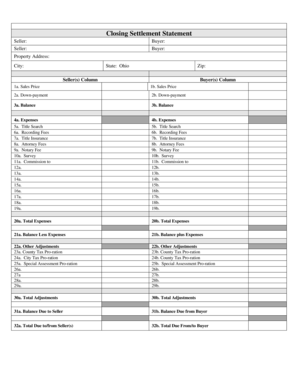Loading

Get Ohio Closing Statement
How it works
-
Open form follow the instructions
-
Easily sign the form with your finger
-
Send filled & signed form or save
How to fill out the Ohio Closing Statement online
The Ohio Closing Statement is a crucial document used during real estate transactions, providing a detailed breakdown of costs associated with the sale. This guide will offer step-by-step instructions on how to complete the form online.
Follow the steps to fill out the Ohio Closing Statement accurately
- Click ‘Get Form’ button to obtain the form and open it in the editor.
- Begin by entering the seller’s information in the designated section. Fill in the seller's name in the 'Seller:' field and any additional sellers if applicable.
- Next, input the buyer’s information in the 'Buyer:' section, including all relevant buyer names.
- Provide the property address in the 'Property Address' field, followed by the city, state (Ohio), and zip code.
- Complete the numerical fields in the 'Seller(s) Column' starting with the sales price in '1a.' and the buyer's sales price in '1b.'.
- Continue by entering the down-payment amounts in '2a.' for the seller and '2b.' for the buyer.
- Next, record the remaining balance for both seller and buyer in '3a.' and '3b.' respectively.
- Fill in the expenses related to both parties, starting from '4a.' for the seller and '4b.' for the buyer.
- Provide details for various fees, including title search, recording fees, title insurance, attorney fees, notary fee, survey, and commission amounts in the relevant fields.
- Calculate and enter the 'Total Expenses' in '20a.' for the seller and '20b.' for the buyer.
- Next, complete the balance calculations by entering the 'Balance Less Expenses' for the seller in '21a.' and 'Balance plus Expenses' for the buyer in '21b.'.
- Record any other adjustments such as tax prorations or special assessments in the respective fields.
- Calculate 'Total Adjustments' in '30a.' for the seller and '30b.' for the buyer.
- Lastly, determine the 'Balance Due to Seller' in '31a.' and 'Balance Due from Buyer' in '31b.'.
- Review all entries for accuracy. Once completed, you can save changes, download, print, or share the form as needed.
Start filling out your documents online today!
A HUD-1 form, also called a HUD-1 Settlement Statement, is a standardized mortgage lending document. Creditors or their closing agents use this form to create an itemized list of all charges and credits to the buyer and to the seller in a consumer credit mortgage transaction.
Industry-leading security and compliance
US Legal Forms protects your data by complying with industry-specific security standards.
-
In businnes since 199725+ years providing professional legal documents.
-
Accredited businessGuarantees that a business meets BBB accreditation standards in the US and Canada.
-
Secured by BraintreeValidated Level 1 PCI DSS compliant payment gateway that accepts most major credit and debit card brands from across the globe.


